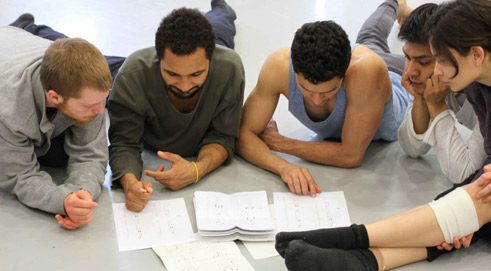Educating choreographers
Choreographing Today

Choreography itself cannot be learned academically, but the skills it requires can. Despite generally gloomy perspectives, creative dancers swiftly find new formats and their niche in the rapidly changing world of dance.
The shortage of choreographers with a well-grounded training has inspired an increasing number of German universities to offer special courses. They all demand similar qualifications for their four-year Bachelor degrees and the subsequent two-year Master courses, and most of them include Dance Pedagogy and Choreography. A university entrance qualification is required, as is a high level of preparatory dance education and a good knowledge of German or English. Applicants for an additional training in choreography are mainly lateral entrants from all over the world. “We have very high standards,” emphasises Ingo Diehl, Professor at the University of Music and Performing Arts in Frankfurt. “But we don’t want education in an ivory tower. For dance professions require flexibility and a cosmopolitan outlook. Foreign applicants are very welcome here. This way, at a very early stage, all the students have the opportunity of taking part in an international exchange of ideas.”
Top performance only on a solid basis
Dance in all its present-day diversity has become something of a national sport here. Initiatives such as “Tanz in Schulen” (Dance in Schools) are gratifying. Of the essence is the basic training in dance – yet here there are also risks involved. For in Germany anyone can open a studio without having to show any qualifications. The Deutsche Berufsverband für Tanzpädagogik (German Professional Association for Dance Pedagogy) is trying to counteract this state of affairs. Since 1975, it has been supporting its 780 members – ballet and dance teacher from all over Germany – with training seminars as well as Dance camps for children and teenagers.The requirements for professional training are high. The financial outlay is considerable. Some 500 Euros per month for school fees with board and lodging already have to be paid for young pupils wishing to train at, for example, the boarding school of the Ballettzentrum Hamburg John Neumeier, at the Palucca-Hochschule für Tanz Dresden (with classical and contemporary courses) or the Staatliche Ballettschule und Schule für Artistik Berlin. From the hundreds of applicants from all over the world no more than 150 are invited for auditions and only 30, at the most, are accepted. Tuition fees for the Bachelor and Master of Arts programmes are minimal in international comparison. But life in Germany is expensive. Since 2010, the “Biennale Dance Education” has been granting insight into the latest developments. Dance experts and students and also, to an increasing extent, guests from abroad meet at varying university venues (2016 in Cologne). Ingo Diehl describes this meeting as “a public platform for the results of outstanding dance education”.
Forming dancing people
Individuality plays a key role in contemporary dance. Thus the Folkwang University of the Arts, Pina Bausch’s artistic home, proclaims: “We do not train dancers, but dancing people.” The forming of dancers’ personalities is also of central importance at the Centre for Contemporary Dance at the University of Music and Dance, Cologne, at the Inter-University Centre for Dance (HZT), Berlin and at the University of Music and Performing Arts in Frankfurt.“Creativity can’t be learnt academically,” says Birgit Keil, former star ballerina of the Stuttgart Ballet. But certain skills of the trade such as spatial arrangement, score reading, theatre science and dance composition are useful props for prospective choreographers, adds Ms Keil, who is currently Director of the Academy of Dance, Mannheim, and of the Karlsruhe State Ballet in Baden. Folkwang Professor Stephan Brinkmann confirms that when it comes to forming artistic expression, the school can only offer the future choreographer a structure and the right atmosphere along with “advice and accompaniment of the artistic process.” Among the youngest talents, the Chinese Fang Yu Shen, already winner of several awards, is attracting much attention. Ingo Reulecke, free performer and for years head of the department Dance and Choreography at the HZT Berlin, observes: “With a solid theoretical foundation young dance artists often create their own formats and niches very quickly.” He names Jana Unmüssig, Kat Valastur and An Ian Kaler from the contemporary Berlin scene. It was at Frankfurt’s University of Music and Performing Arts as well as at the cooperating University of Giessen that the Argentinean Paula Roselen honed her skills. With her bold fusion of the genres, she is currently launching an international career. And it was at the ZZT in Cologne that the multi-talented Stephanie Thiersch made a name for herself.
Meanwhile, almost all German theatres with a dance sector have an evening in the programme in which their own ensemble members arrange the choreography and dance. Pioneers are the Folkwang-Tanzstudio, founded in 1928, and since 1958 the Noverre-Gesellschaft, Stuttgart, where choreographic luminaries such as John Neumeier, Uwe Scholz, William Forsythe and Christian Spuck developed their talents.
Dance residencies, for example, in Mousonturm in Frankfurt/Main, PACT Zollverein – Choreografisches Zentrum NRW in Essen, K3 – Choreografisches Zentrum Hamburg, in the UFA-Studios in Berlin and the Fabrik Potsdam offer up-and-coming choreographers and genre-bending performers temporally limited work possibilities. Not the best, but also not the worst perspectives for choreographers in Germany.